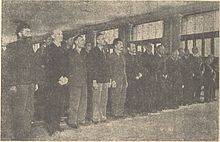Stevan Moljevic
Stevan Moljević (born January 6, 1888 in Rudo , Ottoman Empire , † November 15, 1959 in Sremska Mitrovica , Yugoslavia ) was a Yugoslav lawyer and politician. During the occupation of Yugoslavia in World War II, he was chief advisor to the leader of the nationalist Serb Chetnik movement, Draža Mihailović . As a pioneer of the Chetniks, he demanded in a memorandum in 1941 that the entire territory in which Serbs lived should be " cleared " of non- Serbs . In doing so he transported Ilija Garašin's spatial image of Greater Serbia from 1844 to the present.
Life
Moljević was a Serbian nationalist activist during the Austro-Hungarian occupation of Bosnia and Herzegovina . In the course of a high treason trial against Bosnian Serbs, he was sentenced to imprisonment in Banja Luka in 1916 , which he served until the end of the Danube monarchy .

On June 30, 1941, he published his theses under the title “About our state and its state borders”. In it he proposed a future federal state of Yugoslavia , which should consist of three units: Serbia , Croatia and Slovenia . The Serbian unity should therefore all of Bosnia-Herzegovina , large parts of Croatia ( Dalmatia , East Slavonia and the region around Pakrac , and roughly the area that was to be called Krajina in the 1990s ), as well as Pécs (Hungary), Timișoara (Romania ), Vidin and Kyustendil (Bulgaria), which include all of Macedonia and Northern Albania . The Slovenian unit was to encompass large parts of Styria and Carinthia with Klagenfurt , as well as Friuli-Venezia Giulia with Trieste , all of Istria , Rijeka and the Hungarian border area with Nagykanizsa .
In December 1942, Mihailović appointed Dragiša Vasić , Mladen Žujović and Stevan Moljević to executive committee members of the Central National Committee of the JVuO, which should represent the political arm of the Mihailović movement. Moljević was entrusted with drawing up the political program. His program saw u. a. a "homogeneous Serbia" (a homogeneous Serbia understood at that time a Serbian state in which the Serbs should have an absolute majority in every region), without territorial majorities of national minorities, should include all those areas that were historically and nationally Serbian were deemed. For this purpose, 2,675,000 people were to be resettled from these areas, 1,000,000 of them Croatians and 500,000 Germans . For this purpose, 1,300,000 people of Serbian nationality were to be resettled, 300,000 of them Serbs from Croatia. The Muslims in Macedonia ( Pomaks , Turks ) are also a difficult problem, which if possible must be solved by "resettlement".
At the Ba Congress in January 1944, the Yugoslav People's Democratic Community (JUDENAZ) was founded. The Congress resolution provided for the re-establishment of a federal and monarchist Yugoslavia under the Kara derorđević dynasty , which was to consist of Serbia, Croatia and Slovenia. Further points of the resolution were directed against the AVNOJ decisions of the CPJ . It is uncertain to what extent Moljević now pursued his earlier program of a “homogeneous Serbia”, since Croatian and Bosniak politicians were also involved in JUDENAZ. According to various sources, he continued to advocate these goals.
Some Bosniak and Croatian historians consider Moljević to be one of the leading Chetnik ideologues. Again, however, some Serbian historians consider Moljević's role to be less significant. In the chaos of war, the commanders of the armed Chetnik troops prevailed, so that political figures like Moljević played a subordinate role.

During the trial of Mihailović and 23 other high-ranking members of the Chetnik movement, Moljević was sentenced to 20 years in prison on July 15, 1946 in Belgrade. He died in 1959 while imprisoned in Sremska Mitrovica .
Fonts
- Homogena Srbija (1941). Retrieved December 1, 2013 (Serbian).
Web links
Individual evidence
- ↑ Holm Sundhaussen: History of Serbia: 19. – 21. Century . Böhlau Verlag Vienna, 2007, ISBN 978-3-205-77660-4 , p. 321 .
| personal data | |
|---|---|
| SURNAME | Moljevic, Stevan |
| BRIEF DESCRIPTION | Yugoslav lawyer and politician |
| DATE OF BIRTH | January 6, 1888 |
| PLACE OF BIRTH | Rudo , Ottoman Empire |
| DATE OF DEATH | November 15, 1959 |
| Place of death | Sremska Mitrovica , Yugoslavia |